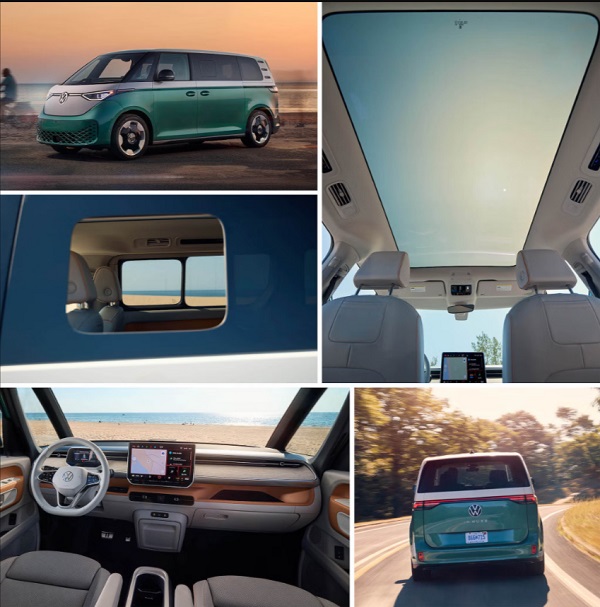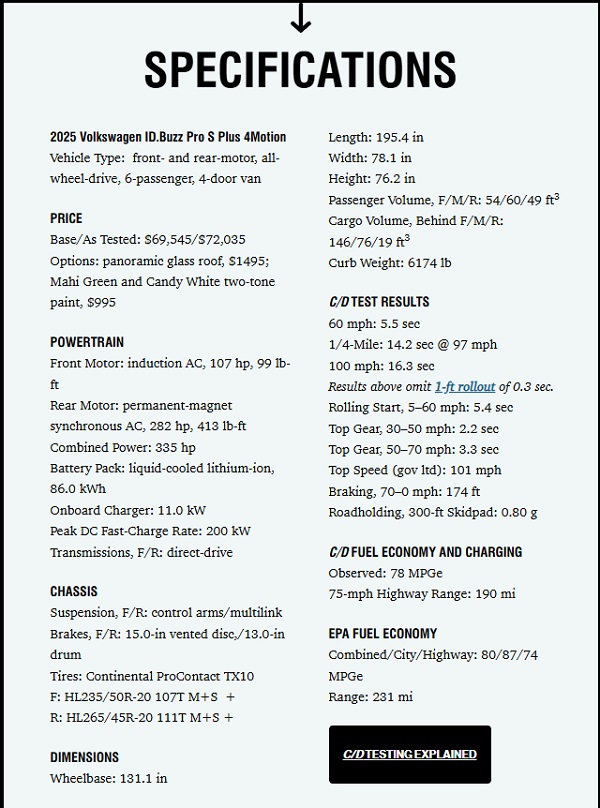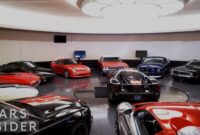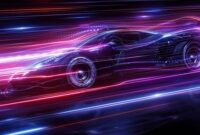The Volkswagen ID. Buzz has been awarded the title of 2025 North American Utility Vehicle of the Year, as announced by Volkswagen of America on Friday at the 2025 Detroit Auto Show.
Volkswagen’s modern take on its classic Microbus, the ID. Buzz, earned the top spot in the Utility Vehicle category, demonstrating its innovative design, state-of-the-art technology, and all-electric powertrain.
“The ID. Buzz is a one-of-a-kind vehicle in the North American market, being the only electric people carrier available today,” remarked Kjell Gruner, President and CEO of Volkswagen Group of America. “We are delighted that the jury acknowledged its blend of style, spaciousness, and sophistication, all contained within a vehicle that produces zero tailpipe emissions. It also brings joy to anyone who spots one on the road.
The 2025 North American Car, Truck and Utility Vehicle of the Year (NACTOY) Awards are widely recognized as one of the most esteemed accolades in the automotive sector, honoring vehicles that set standards in innovation, design, safety, handling, driver satisfaction, user experience, and value. The jury, consisting of 50 prominent automotive journalists from the U.S. and Canada, evaluated the ID. Buzz, which distinguished itself among three finalists in the Utility Vehicle category.
The ID. Buzz features styling inspired by retro aesthetics, sporting a prominent VW logo and lively two-tone exterior paint options that enhance its roomy interior. Three available interior color themes—Moonlight, Dune, and Copper—contribute to its appeal. Standard features include a 12.9-inch infotainment display, 30-color ambient lighting, IQ.DRIVE Level 2-ready driver assistance technology, as well as power sliding doors and tailgate. The rear-wheel-drive ID. Buzz Pro model provides 282 horsepower and has an EPA estimated range of 234 miles, while the 4Motion all-wheel-drive version boasts 335 hp and an EPA estimated range of 231 miles.

The ID. Buzz Pro S Plus trim elevates the experience with features like Easy Open for the sliding doors and tailgate, a Harmon Kardon premium audio system, a head-up display, and AreaView technology. The base model accommodates seven passengers with a second-row bench seat, while the all-wheel-drive and Pro S models come with captain’s chairs, offering seating for six.
The starting price for the ID. Buzz is $59,995 MSRP, in addition to a $1,550 destination charge applicable to all models.
Although the production of the beloved Volkswagen Type 2 Microbus has long since ended, the vehicle’s allure has remained strong in the cultural memory. Emerging in the 1950s, embraced by the youth culture of the ’60s, continuously referenced in media, and utilized for commercial advertising ever since—it’s surprising that Volkswagen waited until now to seriously capitalize on that cultural significance for its gain.
Of course, this isn’t the first time Volkswagen has tapped into its rich nostalgic heritage. The New Beetle—a front-engine, water-cooled reimagining of the original Type 1 Beetle—was introduced in the late 1990s and served as a symbol of the boomer generation’s fascination with its past.
However, integrating the new ID.Buzz EV into the current cultural landscape presents a distinctly different challenge. Combining emotional sentiment with an electric powertrain and modern standards of refinement, safety, and features that were unimaginable just two decades ago, not to mention when the original Bus emerged in the ’50s, is quite a task. Additionally, there’s the challenge of genuinely competing with traditional minivans and the rising segment of three-row EVs led by vehicles like the Kia EV9—all while preserving the essence of the original Type 2.
The new van’s exterior dimensions deviate from those of its predecessor, as one might expect, and yet even with its stout appearance and short overhangs, the design resonates. In comparison to a first-generation Microbus, the 195.4-inch ID.Buzz is 26.9 inches longer. Its width of 78.1 inches is 10.4 inches wider, and surprisingly, its height of 76.2 inches is 0.2 inch lower than that of its predecessor. The wheelbase experiences the most significant increase: the ID.Buzz’s 131.1-inch span is a remarkable three feet longer than the original. For context, the ID.Buzz is 9.8 inches shorter and 0.4 inch narrower than a Honda Odyssey, yet it stands 6.6 inches taller.
According to public feedback, Volkswagen has effectively demonstrated that size is not as significant, or at least it’s a lesser concern. In our informal and subjective polling experiment, which ranged from upscale neighborhoods to a beloved lowbrow, flavor-packed barbecue joint, and from a local guitar shop to a tailgate gathering ahead of a concert featuring Willie Nelson, Bob Dylan, and John Mellencamp, there were absolutely no cases of mistaken identity regarding the ID.Buzz. Older individuals who had fond memories of the original model reacted as anticipated: a squint followed by a quick neck turn, shaking loose the last traces of memories from their youth. What surprised us was that children of various ages universally recognized it, with one saying, “Look, Mom! Is that Fillmore?” (The character is the Bus in the animated film Cars.) Almost everyone was eager to get a closer look and touch it, both inside and out.
As a fully electric vehicle, the ID.Buzz is built on a modified version of the Modular Electric Drive Matrix (MEB) platform, which also serves other Volkswagen Group models, like the VW ID.4 crossover and the related Audi Q4 e-tron. There are two available powertrains: a single, rear-mounted electric motor producing 282 horsepower and an all-wheel-drive variant featuring two motors that generate 335 horsepower (the latter is what we tested). An 86.0-kWh battery gives an EPA-rated range of 234 miles for the single-motor model and 231 miles for the dual-motor version, although in our highway test at 75 mph, we only managed 190 miles in the all-wheel-drive setup.
One specification that would undoubtedly astonish former Type 2 owners is the ID.Buzz’s curb weight of 6174 pounds. Depending on the model and configuration, this is over 3500 pounds heavier than a 1950s Type 2 and roughly 1600 pounds more than a fully loaded current Odyssey. While battery energy density has improved, the substantial weight of electric vehicles remains a challenge. For example, the Kia EV9 GT-Line also faces weight issues at 5839 pounds. However, both vehicles offer a stable, ballast-like feel due to the low placement of their batteries.
The near silence at idle and slower speeds can confuse those unfamiliar with electric vehicles, although noise levels increase as speed rises. Traveling at 70 mph, the interior sound level reaches a notable 70 decibels, which is three decibels louder than both the Odyssey and the EV9. It’s likely that the Buzz’s large, upright front contributes to its elevated cabin noise.
In stark contrast to the original Type 2 Bus, which was infamously slow, the ID.Buzz’s torque-filled electric powertrain allows it to accelerate to 60 mph in 5.5 seconds, outpacing the Odyssey by one second—though the EV9 is a full second faster than the Buzz. The quarter-mile dash took 14.2 seconds in the Volkswagen, which is 0.9 seconds quicker than the Honda and 0.9 seconds slower than the Kia. With acceleration that’s more than adequate, the Buzz takes a similar approach in terms of dynamics, providing precise yet uncommunicative steering and consistent, if not exhilarating, chassis behavior. Maximum grip reached 0.80 g on the skidpad, with some mild understeer, but we can’t envision circumstances outside of a Quentin Tarantino film where anyone would push it to that limit.

In more ordinary driving scenarios, the chassis leans towards comfort, with the exception of a slight front-to-rear porpoising that can occur on mildly uneven surfaces; it’s not overwhelming, and we suspect it could be more pronounced in the short-wheelbase version offered elsewhere. More concerning was the brake pedal’s somewhat inconsistent performance. The initial bite feels more like a nibble, followed by a notably lengthy pedal travel before the regenerative and friction brakes synchronize to slow and stop the vehicle. This is likely due to the regenerative braking strategy, meaning drivers will need to adapt accordingly.
The flat floor, courtesy of the battery-electric powertrain that lacks a driveshaft, is a significant advantage for interior space. The interior design embraces minimalism without feeling inferior. Subtle design elements recur throughout, and our test vehicle featured the Dune color scheme, combining a creamy off-white with tan accents effectively. Two other themes are available: Copper and Moonlight. Volkswagen’s designers could have easily overwhelmed the interior with excessive retro graphics and kitschy, vibe-inspired hippie themes; thankfully, they avoided that.
Our ID.Buzz featured captain’s chairs in the first two rows and a unique captain-like arrangement for the third row. The seats provide multiple adjustments and deliver a commendable level of supportive comfort. The instrument panel and infotainment system are typical of Volkswagen. While we’re still not fond of the haptic controls, the enhancements introduced with the 2024 ID lineup have improved them, and we have adapted to using them. Unfortunately, we cannot say the same for the quirky power-window system, which consists of just two switches and requires toggling a third to manage the rear sliding windows—another cost-cutting measure carried over from the ID.4.
In a positive change from the original model, which only had a thin piece of steel shielding your lower body from potential hazards, the ID.Buzz now includes a proper crumple zone. The large windshield provides exceptional visibility, and the expansive dashboard has enough space to create a fully accurate 1/1000th-scale diorama of the Woodstock music festival, complete with debris.
There are three trim levels available: Pro S, Pro S Plus, and a launch-exclusive First Edition. Buyers can select from three solid exterior colors (Metro Silver, Candy White, or Deep Black Pearl) and eight two-tone combinations, including the $995 Candy White paired with Mahi Green of our Pro S Plus all-wheel-drive test model. The innovative electrochromic, variable-tint glass roof added $1495, raising our test vehicle’s total to $72,035 (the equivalent rear-wheel-drive variant costs $4500 less). It’s important to mention that the short-wheelbase two-row and commercial versions, both offered in Europe, will not be available in the U.S.
In terms of design, ride comfort, and smart interior layout, Volkswagen’s ID.Buzz meets expectations. However, EVs continue to be assessed based on rough consumer calculations that essentially divide the purchase price by the vehicle’s range. In that respect, the ID.Buzz falls short when compared to the long-range version of the EV9, as well as many electric sedans and SUVs that offer over 300 miles per charge. Plus, there are gasoline and hybrid alternatives to consider.
Nonetheless, the ID.Buzz benefits from a sense of nostalgia and significant novelty that will attract customers to Volkswagen dealerships. Convincing them to make a purchase, however, is a separate challenge. As one enthusiastic older gentleman in a vintage Rolling Stones 2024 Hackney Diamonds Tour T-shirt remarked when informed about the ID.Buzz’s $61,545 starting price: “Heck, that’s a reasonable price. I have Grandma’s inheritance.”
Counterpoints
The ID.Buzz fulfills its intended purpose perfectly. It’s not designed to initiate an EV revolution; in fact, it isn’t even targeting high sales figures. It’s a delightful throwback that integrates modern technology, and in that capacity, it surpasses expectations. The design is charming (and, like many other nostalgic cars, it’s filled with little hidden features), but fundamentally, the ID.Buzz is a dependable minivan. There’s an abundance of light and ample usable space, with plenty of storage solutions, all supported by an energetic powertrain, even if its overall range isn’t remarkable. If you can only have one vehicle in your garage that makes a statement while still being versatile, the ID.Buzz delivers. —Andrew Krok

Critics may justifiably argue that the ID.Buzz is overpriced for its range capabilities, but its character is also significant, and this electric vehicle has plenty of it. It doesn’t resemble the typical two-box SUVs available today. Unlike many competitors, this bus stands tall (the Hyundai Ioniq 5’s roof barely reaches the ID.Buzz’s beltline) and offers a spacious, airy cabin for everyone, regardless of their seating position. Unfortunately, VW continues with the criticized capacitive controls for the steering wheel and some infotainment and climate control functions. However, those touch controls don’t disturb me as much in this context compared to the GTI, likely due to the ID.Buzz’s more laid-back nature. If the range isn’t sufficient for your road trip, you can always rent a conventional van. I’m a fan. —K.C. Colwell
Volkswagen first unveiled the ID.Buzz concept in 2017. The following year, construction commenced on the Sphere in Las Vegas. By 2023, the Sphere—an unprecedented architectural and technological feat—was inaugurated and hosting concerts, including a 2024 residency from Dead & Company. Volkswagen, aware of its ties to the Deadhead counterculture, displayed a vintage Bus alongside an ID.Buzz in Vegas. However, the latter was a pre-production model since the final version of the production van was still incomplete! When I tested the European ID.Buzz in 2022, I anticipated that we would soon be enjoying our own vans. But, like a jam-band improvisation, U.S. certification can’t be rushed, man. At least it proved to be worth the wait—this vehicle is fantastic. —Ezra Dyer


